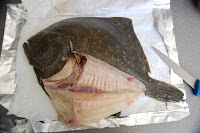Now, as you can no doubt see from the photograph - my tower was somewhat less impressive than the one the genious team at Bompass and Parr created - as despite my love of eating jelly, I've never been very sucessful at making it! I think it could have something to do with my ponchon for adding booze to jelly and the catastrophic effects that alchohol seems to have on the setting agents. Whilst I did sucessfully manage to get my first jelly out of its mould in one piece - I could not, for all the tea in china, manage to make the darn thing stand upright, and I decided a roly-poly sidesliding jelly looked worse than upturning the glasses I made them in. The actual jelly was delicious - blackcurrent with cassis at the bottom, a sharp raspberry with chambord in the centre. Top off with elderflower with the peary hint of eau-de-vie - we just had to eat them from the container with a spoon.
That was my second disaster of the day as my first attempt at a gentle rippled meringue had all gone very wrong as I had followed the magazine recipe which called for me to cook the meringue like a sabayon over a water bath - the resulting bubble gum pink liquid went straight in the bin and out came my faithful Cookery Bible for Prue's unfailing meringue recipe and batch two was peaky perfection. Adding the ripples with the use of a gel food colouring on a cocktail stick reminded me of those marbling inks we used to use at school which you floated on water and stirred around to get the swirly pattern before dropping your paper in and taking the ink off the water. Very satisfying.
I served cocktails on the day which also went down very well and were greatly enjoyed in the moment of sun when the wind and rain finally died down. It was a twist on a kir-royal, instead of raspberries, I used homemade blackberry puree (as I couldn't find any Creme du Mure), added blackcurrent gin and elderflower cordial and added a tablespoon of the resulting syrup to the bottom of a glass and topped up with champagne.
Unfortunately, due to the on/off rain and juggling all the cooking, I didn't manage to get any photos of the rest of the BBQ food, just the dessert but the basic menu was as follows:
- Aubergine Vinaigrette
- Courgette & Goats Cheese Rolls
- Chickpea & Feta Salad
- Potato & Quails Egg Salad (Valentine Warner's recipe)
- Plaice fillets with Clams and Samphire in Caper Buerre Noisette
- Beef and Parmesan Mini Burgers or
Mushroom and Parmesan Mini Burgers - Sparkling Cranberry-Vodka Chicken Kebabs
- Butternut Squash and Corn Koftas
- Morrocan Spiced Lamb Rump
The other standout dish of the day was the butternut squash and corn koftas - a simple mix of roasted squash (sprinkled with cumin and corriander when roasting) blitzed with chickpeas, coarsley ground pistacios, breadcrumbs and tahini. Fresh corn and parsley are stirred in after blitzing and then the mixture moulded on kofta skewers. Really nice vegetarian BBQ alternative but it went great with the spice lamb rump in a pitta too....
Cheers ladies - same time next year?
Raspberry & Marzipan Cupcakes
Cupcakes
250g butter - at room temperature250g caster sugar
250g self raising flour
2 eggs
1 teaspoon baking powder
150g marzipan
up to 4 tablespoons milk
raspberry jam (seedless is best)
Topping
100g butter (must be at room temperature not from the fridge)200g cream cheese
300g icing sugar
1 teaspoon amaretto or almond extract
fresh raspberries and pearly sugar sprinkles to decorate
Method
Set oven to 175 C or Gas 4
Line 18 muffin moulds with cupcake cases
Dice the marzipan into 5mm cubes - put in a bowl with one tablespoon of flour and toss to keep the individual cubes from clumping. The flour coating will also prevent the marzipan from sinking to the bottom of the cupcakes when cooking.
Cream the butter and sugar until light and fluffy
Add the flour, baking powder and eggs and beat until combined and fluffy. The consistancy should be that of whipped cream - if its a little thick, add some milk, a tablespoon at a time and beat to combine.
Gently fold the marzipan cubes through the mixture.
Spoon one teaspoon of cake mixture into the bottom of each cupcake case.
Add half a teaspoon of raspberry jam to the centre of each cake.
Add another teaspoon of cake mixture to each case, taking care to completely cover the blob of jam.
Bake for 15 - 20 minutes or until risen, firm to the touch and golden.
Allow to cool for 5 mins in the tin then transfer to a cooling rack.
While the cakes are in the oven, make the frosting.
Cream the cheese and butter.
Turn the mixer to its lowest speed to prevent puthering and add the icing sugar and flavouring.
When the cakes are completely cool, pipe or spoon the frosting onto each cake, sprinkle with frosted sugar strands (or hundred and thousands for a retro feel) and top each with a fresh raspberry.










